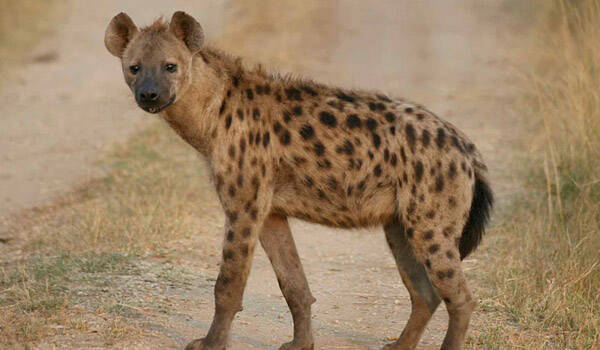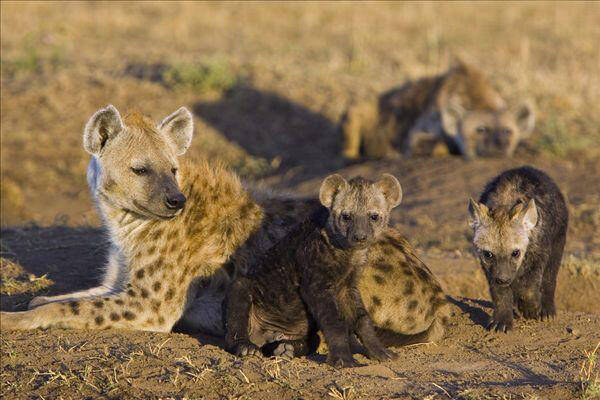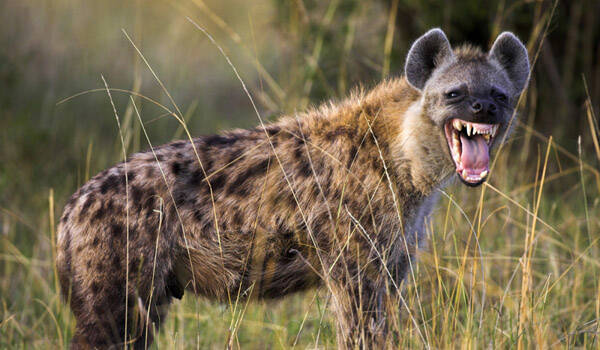Crocuta crocuta
IUCN
LCBasic Information
Scientific classification
- name:Crocuta crocuta
- Scientific Name:Crocuta crocuta,Spotted Hyaena,Spotted Hyena
- Outline:Carnivora
- Family:Hyaenodon Hyenaidae Hyaenodontinae
Vital signs
- length:90-160cm
- Weight:45-82.5kg
- lifetime:12-25years
Feature
It can compete with lions and is the most vocal mammal in Africa.
Distribution and Habitat
Origin: Angola, Benin, Botswana, Burkina Faso, Burundi, Cameroon, Central African Republic, Chad, Congo, Democratic Republic of Congo, Côte d'Ivoire, Djibouti, Equatorial Guinea, Eritrea, Ethiopia, Gambia, Ghana, Guinea, Guinea-Bissau, Kenya, Malawi, Mali, Mauritania, Mozambique, Namibia, Niger, Nigeria, Rwanda, Senegal, Sierra Leone, Somalia, South Africa, South Sudan, Sudan, Swaziland, United Republic of Tanzania, Uganda, Zambia and Zimbabwe.
Possibly extinct: Algeria, Togo.
Wandering: Gabon.
Inhabits a variety of open or dry environments, including semi-deserts, savannahs, woodlands, acacia jungles and montane forests, and is less common in dense forest habitats. Does not inhabit coastal rainforests of West or Central Africa. In West Africa, the species prefers grasslands of Guinea and Sudan. In East Africa and Ethiopia, it can be found at altitudes up to 4,000 m above sea level.
Appearance
The total length of the spotted hyena is 1.3-1.85 meters, the tail length is 25-36 centimeters, the male weighs 45-63 kilograms, and the female weighs 55-82.5 kilograms. Female individuals are significantly larger than males, weighing more than 14%. The spotted hyena has high shoulders and powerful forequarters and sloping hindquarters. The hair is short and coarse, and the color is earthy yellow, brown, sandy, ginger, dark gray or brown. It gets its name from the black or brown patches and spots on the back, sides, buttocks and legs. These irregular dark spots on the body will fade with age. The nose tip is black. They have a long and strong neck with a rough mane. The tail is short, brown-black, and the tail end is dense.
The body is dog-like, with a long neck, shorter and weaker hind limbs than the forelimbs, a short body, high shoulders and low buttocks; there is a long mane on the midline of the back behind the neck; the teeth are large, with thick conical premolars, developed
Details
Spotted hyena (scientific name: Crocuta crocuta), also known as spotted hyena, is a member of the genus Crocuta and family Hyaenidae.

The spotted hyena was first formally described by German naturalist Johann Christian Polycarp Erxleben in 1777. The ancient Greek root of the name was used by Pliny the Elder (Gaius Plinius Secundus) to describe an unidentified animal in Ethiopia, possibly the hyena. This root comes from the scientific name of the genus Crocus, an ancient yellow dye. Literary meaning is "saffron-colored object". The spotted hyena is the largest living member of the family Hyaenidae. It is believed that the ancestors of the spotted hyena branched off from the striped hyena during the Pliocene (5.33-1.8 million years ago). As saber-toothed tigers began to disappear and were replaced by short-toothed cats, some hyenas began to hunt on their own and evolved into new species, including the spotted hyena today.
The spotted hyena's pack can include 5-90 members and is led by a female. The pack lives around a den, where only the cubs live. Each pack is a permanent social group. The pack is influenced by a complex social hierarchy, which cubs will recognize even before they learn to walk. Females are the dominant members, followed by cubs, and adult males are the lowest level. Their society is highly structured and dominated by matrilineal clans (females born to a single mother). Their social behavior is very complex, often involving alliances and transfer of ties. In this respect spotted hyenas resemble many Old World primates more than other carnivores. Male spotted hyenas leave the clan at about 2 years of age, while females remain in their natal clan.
Members of the lower-ranking clan of spotted hyenas lick the genitals of higher-ranking females as a sign of continued submission. All males in the clan lick the genitals of the alpha female, and since the highest-ranking males are below the lowest-ranking females, it is rare for female spotted hyenas to lick the penis of males. Females tend to mate with males from other clans to prevent inbreeding. Female spotted hyenas rarely mate with highly aggressive males, instead choosing calmer and more submissive males. Patience is essential, as courtship can sometimes last up to a year. Therefore, superior and impatient males will have a hard time finding a mate. Despite the complexity of courtship, females raise their cubs on their own. Cub killing is very common, and other females (sisters of the cub's mother) will kill the cub.

Spotted hyenas of the same group rarely fight each other to the point of serious injury. Many arguments are resolved quickly. Yelling and minor biting are sufficient, but if a fight gets out of control, higher-ranking hyenas will intervene and stop it. Even hyenas that do not know each other will try to avoid fighting or killing each other. Scent markings left by hyenas also prevent disputes: if a hyena needs to enter the territory of a rival hyena, it will keep a low profile and try to stay on the border. Females are more hostile to each other, because males from different groups have mating purposes. Strangers are rarely accepted into the group, but if they are accepted, they will only be the lowest in the group. In the event of a large confrontation, such as with lions or other hyena groups, hyenas will build a "wall" shoulder to shoulder and attack the opponent as a whole.
Like many other carnivores, spotted hyenas like to play, especially when they are young. Spotted hyenas can be very docile when kept in captivity, and many native Africans and Europeans living in Africa can successfully domesticate spotted hyenas.
Spotted hyenas excrete oily and yellow substances to mark their territory. Their anal pouches will turn outward, forming a posture of obedience to the leader. They will also use their claws to catch the secreted substances on the ground, forming an olfactory boundary.
Spotted hyenas are nocturnal beasts. They rest in the grass or caves during the day and come out at night to wander around and look for food. They hunt alone, in groups or with a few people. Sometimes 40-60 people will hunt large animals such as zebras and bison in an organized manner.

Although spotted hyenas are well adapted to a carrion-eating lifestyle, they obtain most of their food through hunting. Their teeth are not specifically designed for carrion-eating, but have developed into a more "all-round" one. Spotted hyenas seem to prefer medium-sized ungulates (such as wildebeest or zebra) over large (such as African buffalo) or small (such as Thomson's gazelle) animals. Unlike wolves, spotted hyenas rely on vision rather than smell to select their prey. Based on their hunting methods, spotted hyenas generally choose animals with lower physical fitness in the group. Spotted hyenas hunt in a similar pattern to African wild dogs, chasing their prey over long distances until they are exhausted. When hunting large prey, spotted hyenas bite the lower body of their prey and tear open its abdomen. They usually eat the internal organs and leg muscles first. If the prey is a pregnant female, they will eat the fetus first and save the head for last. A spotted hyena can eat 14.5 kg of meat at a time, which is about one-third of its body weight, which is a very high appetite among mammals.
Spotted hyenas rarely attack African buffalo due to differences in their habitat, but there are still reports that they have killed an adult male buffalo. Spotted hyenas also hunt other animals, including fish, turtles, black rhinos, hippos, Elephants-Are-Endangered.html">elephants, crocodiles, pangolins, honey badgers, jackals, lions, livestock, dogs, and humans. Spotted hyenas eat more carrion during the day, which attracts vultures. They also stay closer to lions or humans than other African predators. They sometimes hide food, and there are reports that some spotted hyenas hide food in water. Spotted hyenas only drink very little water, usually for no more than 30 seconds. Their digestive system has strong stomach acid, which helps them completely digest the entire prey, including its skin, teeth, horns, bones and hooves. Due to the large amount of calcium they consume, their feces are crusty and white. In addition, they can absorb nutrients from mummies. Spotted hyenas will spit out the parts that cannot be digested. During the breeding season of wildebeests, there are too many prey caught and spotted hyenas will only choose some parts to eat, so many abandoned bones can be found in places where wildebeests are dense. Spotted hyenas will scramble to eat their prey, but they compete with each other in terms of speed rather than fighting.
Spotted hyenas are the most vocal mammals in Africa, with more than 11 different sounds being discovered.
The complexity and intensity of the relationship between spotted hyenas and lions is unique. Lions and spotted hyenas are both top predators, hunting the same animals, so they are actually in direct conflict. They will fight each other and steal each other's prey. In the Ngorongoro Conservation Area in Tanzania, the number of spotted hyenas greatly exceeds the number of lions, so it is actually the lions that steal the spotted hyenas' prey, not the spotted hyenas that steal the lions' prey as most people think. In addition to hunting for themselves, hyenas often steal prey caught by other carnivores, such as cheetahs and even lions. Their powerful bite is enough to scare off cheetahs, and they can snatch prey from lions if outnumbered more than three to one.
The urogenital system of female spotted hyenas is unique among mammals. The female clitoris is long, like an erect penis, with the vaginal opening at the top, so it is the only way to distinguish sex. Females use this organ to urinate, mate, and give birth. Since mating is impossible without the help of the female, female spotted hyenas can choose who to mate with. Like spider monkeys, males have no styloid penis. Because the birth canal turns to the clitoris at about the level of the vulva, and the clitoris itself is very narrow, childbirth is difficult for spotted hyenas. Many first-time mothers in captivity have stillborn babies due to long labor. It is believed that 10% of first-time mothers in the wild die in labor. Spotted hyenas usually have two puppies per litter, and they take 10 months to nurse.
The gestation period of spotted hyenas is about 4 months. The cubs are born with their eyes open and teeth fully formed. At birth, the cubs weigh about 1-1.6 kg and will bite each other. Fetuses of the same sex will fight with each other and even die. An estimated 25% of the mortality rate is due to cubs biting each other. Since a single fetus can get more food and grow faster, this kind of behavior can be regarded as an adaptation. Spotted hyena milk is very nutritious. The protein content is the highest among land carnivores, accounting for 14.9%, and fat accounts for 14.1%, second only to polar bears, so they cannot abandon their cubs like lions or wild dogs. 2-6 weeks after birth, the cubs will be moved to the den. The cubs are completely dependent on breast milk for 8 months and will not be weaned until they are 12-16 months old. Spotted hyenas mature at 3 years, and females mature slower than males. Males generally leave the den at 2 years of age, while females remain in the den.
The spotted hyena population is declining due to human persecution, with trapping and poisoning being the main causes outside protected areas. In the Serengeti, the cause of death is the mortality rate of spotted hyenas due to snares set by people to capture wild herbivores, with about 400 killed each year in snares (Hofer et al., 1996). Apparently, bushmeat hunting has expanded rapidly since the mid-1970s, with more and more people hunting near the boundaries of protected areas, such as in the northern and western Serengeti. Many animals are killed, some by vehicle strikes. The survival of spotted hyena populations is also threatened by other wild animals, such as lions, cheetahs and rhinos. Residents poison them because they suspect the species of predating livestock, and local indigenous people also kill them for food, medicine and witchcraft (Hofer and Mills 1998). Another major threat to wild species is caused by humans. The loss of habitat due to increasing human settlements, overgrazing, and hunting density will cause the species to decline.
Listed in the "Red List of Threatened Species of the World Conservation Union" (IUCN) 2014 ver3.1-Least Concern (LC).
Protect wild animals and eliminate game.
Maintaining ecological balance is everyone's responsibility!








